Similar But Not the Same, Here Are the Differences Between Seals, Sea Lions, and Walruses!
Seals, sea lions, and walruses are all mammals. They belong to the Sub-Order Pinniped, but are grouped into different families, namely Phocidae (seals), Otoriidae (sea lions), and Odobenidae (walruses). “Pinniped” means “fin-footed.” Many people have difficulty distinguishing between these three animals because of their similar body shape. However, they have some differences, both physically and behaviorally. Curious about what the differences are? Let’s take a look at the explanation below!
Seals
Seals average 1.2 meters long and weigh 30 kg. However, there are also large ones, namely the southern elephant seal (Southern elephant seal) which has a body length of up to 4 meters and weighs 2,200 kg. Generally, they live in the waters of the northern and southern poles, but the Hawaiian monk seal lives in warm waters.
Their body surface is covered with thick and smooth fur. They do not have ears, but only small holes on the sides of their heads. Seals walk by dragging their bodies, assisted by their hind fins. Because their forelimbs are weaker, their hind limbs are used for swimming.
These marine mammals are calm animals that do not like noisy environments. They usually communicate by sniffing or snorting. They also prefer to spend their time in the water.
Sea Lions
On average, sea lions are 2.4 meters long and weigh 300 kg. The Steller Sea Lion (Eumetopias jubatus) is the largest species of sea lion with a body size of up to 3 meters and weighing 1,000 kg. The habitat of sea lions is in almost all the waters of the world, except the Atlantic Ocean.
They have ears like terrestrial mammals in general. In addition, they also have four fins that are used for walking and swimming. These fins also function to rotate their bodies. The surface of the sea lion’s body tends to be smooth and hairless.
Sea lions are social animals and love to communicate. In a sea lion herd, loud shouts or barks are often heard. Female sea lions also make sounds to be recognized by their offspring.
Walruses
Walruses can grow up to 3.6 meters long with an average weight of 1,000 kg. Walruses live in cold waters, namely in the Arctic and sub-Arctic Oceans. In the wild, these animals can live for more than 40 years.
The most prominent characteristic of walruses is their pair of tusks. Tusks serve as a defense tool and a determinant of social status. Male and female walruses both have tusks. Walruses walk and swim using their four fins at speeds of up to 35 km/h.
Like sea lions, walruses are social animals that like to flock together. A herd of walruses can contain hundreds to thousands of individuals, especially during the mating season. The male walrus with the largest tusks becomes the leader of the herd. In addition, the strongest male walrus is also the first to choose a female to mate.
Despite their differences, these three animals all play an important role in the marine ecosystem. They help control the population of fish and other small marine animals. Therefore, we must preserve the marine environment so that these animals can continue to live and reproduce. We can protect the ocean by reducing plastic use, not littering in the ocean, and supporting marine conservation activities.
Shrimp and Tuna Regain Their Status as Indonesia’s Leading Fishing Export Commodities
Shrimp and tuna regained their status as Indonesia’s leading fishing export commodities in the first six months of 2023. According to a report by the Ministry of Marine Affairs and Fisheries (KKP), the total value of Indonesia’s fishing exports in that period reached around 2.8 billion US dollars, or equivalent to Rp 44 trillion.
The United States, Japan, and China were the main export markets for Indonesian fishing products during this period. The high value of fishing exports is the result of contributions from both the capture fishery and aquaculture sectors.
This time, let’s discuss the conditions of Indonesia’s fishing exports in the first half of 2023 and its potential in the future.
1. Shrimp and Tuna as Main Commodities
Shrimp is the category with the largest value in fishing exports, at 567 million US dollars, or equivalent to Rp 8.9 trillion. There are three types of shrimp that are the main ones, namely vannamei shrimp, windu shrimp, and merguensi shrimp. The main market for Indonesian shrimp is the United States.
In 2022, the United States also became the main export destination for Indonesian shrimp with a market share of 60%. This makes Indonesia the third largest shrimp exporter in the world.
Next, tuna-skipjack-mackerel (TCT) became the second largest export commodity, with an export value of 282 million US dollars, or equivalent to Rp 4.4 trillion. Japan is the main export market for this category, especially tuna, which is the product with the highest demand.
Tuna is very popular in the global market because it has a delicious and nutritious taste. As a source of animal protein, tuna is often used as a main ingredient in popular dishes, such as sushi and sashimi.
2. Diversification and Potential of Fishing Production
Squid-cuttlefish-octopus (CSG) is also one of the fishing export commodities with a high value, at 195 million US dollars, or equivalent to Rp 3 trillion. The main market for CSG is China. In addition to the three categories mentioned, fishing export commodities also include crab, lobster, pearl, seaweed, and other marine products, including processed products.
Director of Marketing of the Directorate General of Strengthening Competitiveness of Marine and Fisheries Products (PDSPKP), Erwin Dwiyana, said that the potential for Indonesian fisheries can reach 12 million tons per year. KKP is optimistic that Indonesia’s rich marine resources can support fishing product export activities.
3. The Future of Indonesia’s Fishing Exports
Indonesia’s fishing exports are expected to continue to grow in the future. This is supported by various government efforts to improve the competitiveness of Indonesian fishing products in the international market.
One of KKP’s efforts to increase fishing product exports is to hold Foreign Buyers Mission (FBM). In this activity, KKP invites potential importers from various countries to see Indonesian fishing products directly. This activity aims to help importers better understand the potential of Indonesian fishing products, thus increasing their export opportunities.
Shrimp and tuna are the most exported Indonesian fishing products. KKP is working to optimize fishing production to meet the 2023 export target of USD 7.66 billion, or equivalent to Rp 116.1 trillion.
Aruna is committed to supporting the increase in Indonesia’s fishing exports. We provide a digital platform that connects fishermen with buyers from various countries so that it helps fishermen reach a wider market. Since 2016 to date, Aruna has been in 31 provinces in Indonesia with more than 40,000 registered Aruna fishermen. In early 2023, Aruna has grown by 62% compared to the previous year.
Direct Call Mechanism Makes Export Time and Cost of Fishery Products More Efficient
Fishery product exports play an important role in the Indonesian economy. According to data from the Ministry of Marine Affairs and Fisheries (KKP), in 2022, the value of fishery product exports from Indonesia was recorded at USD 6.24 billion, an increase of 9.15% from the previous year.
The main export destinations for Indonesian fishery products are dominated by Asian countries, such as Malaysia, Singapore, Japan, Hong Kong, and China. In addition, fishery product exports are also made to the United States, Australia, and various other countries.
Up to now, air transportation has been a popular choice for shipping fishery products. However, the need for transit flights has been a barrier to air transportation of fishery products. The government is working to overcome this barrier by opening access to “Direct Call” flights.
1. Direct Call as an Export Efficiency Effort
Direct call flights are direct flights from one airport to another without transit. Previously, cargo flights from Indonesia to export destinations had to transit in Jakarta. However, at present, cargo shipments to the destination can be made directly from the city of origin, such as on the routes Manado-Tokyo, Ambon-Sydney, and Makassar-Hong Kong. Exporting fishery products through direct call flights has three advantages, namely:
- Shorter shipping time Fishery products from Indonesia can be sent directly to the destination country, so the shipping time is shorter.
- Cheaper costs The cost of shipping through direct call is generally cheaper than shipping through transit. In addition, there are no additional costs for temporary product storage.
- Better product quality Fishery products do not need to undergo a transit process that can reduce their quality.
2. Maintaining the Quality of Fishery Export Products
Exported fishery products must be guaranteed in terms of quality and safety. In this regard, the Indonesian Central Fisheries Quarantine and Quality Control Agency (BKIPM) plays a role in ensuring this. BKIPM carries out fish quarantine checks and quality testing to ensure that exported fishery products meet the established quality standards.
The Head of BKIPM Makassar, Siti Chadidjah, emphasized that BKIPM will always support efforts to ensure the quality and safety of fishery products. This aims to increase export opportunities, product selling prices, and consumer confidence in Indonesian fishery products.
3. Government Support for Fishery Product Exports
The KKP, together with the provincial and district governments, collaborate to ensure the success of fishery product exports. This collaboration is carried out to improve the efficiency and effectiveness of exports, as well as to improve the competitiveness of fishery products in the global market.
As stated by the Minister of Marine Affairs and Fisheries, Sakti Wahyu Trenggono, the KKP will provide support to fishery businesses. This support includes mentoring, certification, market potential analysis, and assurance of the quality and safety of fishery products.
Direct call flights are a positive step to increase fishery product exports. This mechanism is expected to reduce export costs and time, so that Indonesian fishery products can reach international markets more quickly and easily.
Aruna, as a fishery company committed to sustainable fisheries, also supports the increase in fishery product exports. We help fishermen to reach a wider market, both domestically and internationally.
You can also support the export of fishery products by consuming more local seafood. This will increase the demand for Indonesian fishery products and create greater export opportunities for the fisheries sector. With joint efforts, Indonesia can become the world’s largest producer of fishery products.
Aruna Zero Waste: Transforming Fishery Waste for a Sustainable Marine Ecosystem
The fisheries industry is a vital sector for Indonesia, but its massive production scale poses challenges in waste management. Fishery waste, comprising heads, bones, skins, fins, scales, and entrails, is estimated to account for 30-40% of the total weight of fishery products.
Improperly managed fishery waste can have negative environmental impacts, including pollution and damage to marine ecosystems. To address this issue, the Ministry of Maritime Affairs and Fisheries (MMAF) encourages all stakeholders to embrace a zero-waste approach in the fisheries industry. What is the concept of zero waste in fishery products, and how is Aruna working to implement it?
Zero Waste in Fishery Products
The concept of zero waste in fisheries involves utilizing every part of the fish and minimizing waste. Budi Sulistiyo, Director General for Strengthening the Competitiveness of Marine and Fisheries Products, highlights that every component of a fish can be turned into an economically valuable products.
For example, in the application of zero waste to fish, fish meat can be processed into fillets, steaks, and loins. Meanwhile, fish bones and heads can be transformed into snacks, pharmaceutical ingredients, and industrial materials. Additionally, fish entrails can be used to produce livestock feed.
Trisna Ningsih, Head of the Central Testing Institute for the Application of Marine and Fisheries Products, explains that the value of fishery products can be enhanced through processing. Raw fish has a low value due to its perishable nature. However, processing fish into processed foods, health supplements, cosmetics, pharmaceuticals, and animal feed can increase its value.
Zero Waste as Part of Sustainable Fisheries
The application of zero waste in fishery products is a form of sustainable fishing practice, consisting of three principles:
1. Selective fishing, using environmentally friendly methods and gear while avoiding overfishing.
2. Efficient fish processing, involving the utilization of every part of the fish.
3. Creative waste utilization, transforming waste into useful and value-added products.
By implementing these principles, the amount of fishery waste ending up as trash is reduced, supporting the sustainability of marine ecosystems.
Aruna Zero Waste Hub
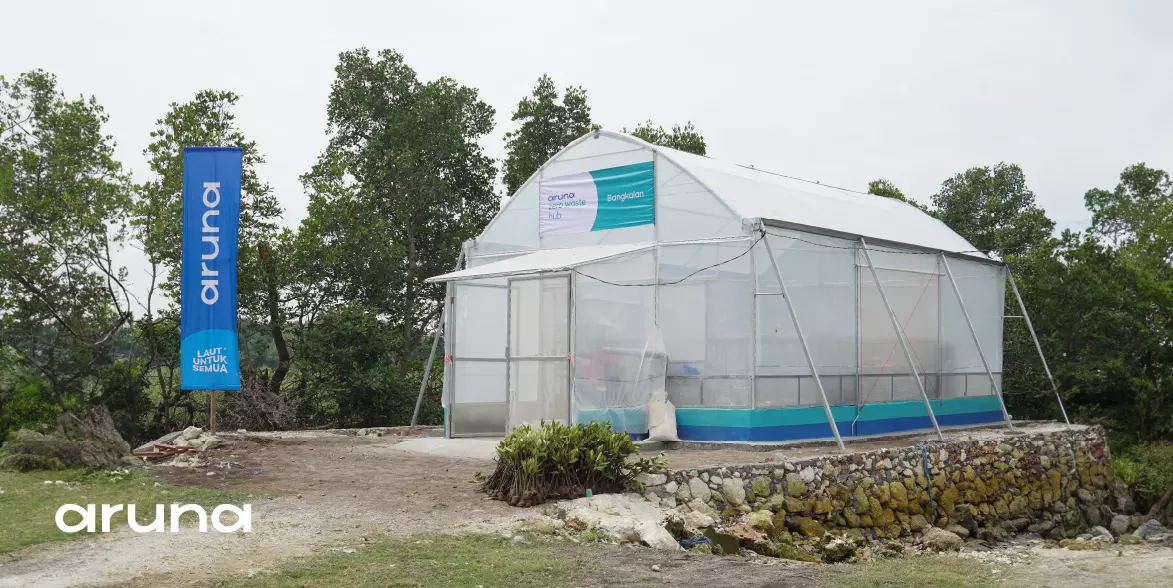
As a fisheries company committed to environmental sustainability, Aruna also adopts zero waste management. The Aruna Zero Waste Hub is established to reduce, or even eliminate, fishery production waste.
One of our hubs in Bangkalan, East Java, has a drying facility to process crab shells into fish feed. Activities at the Aruna Zero Waste Hub involve coastal communities guided by Aruna’s Local Heroes. The goal is to minimize waste and diversify products.
Jerry Sambuaga, Deputy Minister of Trade, states that Aruna’s zero waste program is part of the effort to achieve Sustainable Development Goals (SDGs) related to Sustainable Cities and Communities. Through the Aruna Zero Waste Hub, we support MMAF’s initiative to implement zero waste in fishery products. Additionally, we conduct education and awareness campaigns on utilizing fishery waste to support sustainable fisheries.
As consumers, you can contribute to this zero-waste program by choosing fishery products from sustainable sources and utilizing every part of the product. For instance, turning fish heads into delicious dishes, consuming shrimp with their heads and shells, and cooking squid with its ink.
The implementation of zero waste in fishery products can bring widespread benefits to the environment, economy, and society, representing a crucial step toward realizing a sustainable future for our oceans.
Aruna Supports KKP in Developing Human Resources for Sustainable Fisheries Implementation
The Ministry of Maritime Affairs and Fisheries (KKP) is dedicated to achieving sustainable fisheries management in Indonesia. One of its key initiatives is the implementation of the Measured Fish Capture (PIT) policy, a priority agenda within the Blue Economy framework. PIT regulates fish catch quotas and zones with the aim of preserving fisheries resources, protecting the environment, and promoting national economic equality.
The PIT policy involves developing highly skilled Human Resources (HR) in the fisheries sector. Through this program, the Marine and Fisheries Human Resources Development and Extension Agency (BPPSDM KP) places students from KKP’s educational units in various fishing ports across Indonesia.
Placing HR through Internship Programs
Students from KKP’s educational units are given the opportunity to learn at post-production fish landing bases. The placement of students in 30 fishing ports is part of the implementation of the Field Work Practice curriculum.
Internship programs are considered a strategic step in developing fisheries HR. During these programs, students engage in landing management, including recording data on the quantity and types of fish, knowledge of Fishing Gear (API), and activities in fishing ports. The goal is to enhance the skills and competencies of students and involve them directly in sustainable fisheries management practices.
The Importance of PIT Implementation for Sustainable Fisheries
The Head of BPPSDM KP, I Nyoman Radiarta, recognizes the importance of PIT as an effective method for implementing sustainable fisheries and maintaining the balance of marine ecosystems. BPPSDM KP is committed to fully supporting all programs related to PIT.
PIT implementation requires trained and competent HR in various aspects of fisheries management. Therefore, the government will continue to improve the quality of education and training for students from KKP’s educational units. “We will all work together with the team, instructors, and relevant stakeholders to ensure that this activity runs smoothly and effectively,” said Nyoman.
Minister of Maritime Affairs and Fisheries, Sakti Wahyu Trenggono, emphasizes the importance of excellent HR in achieving the success of the Blue Economy Program and Policy. HR quality must be a top priority, especially in sustainable fisheries management.
Aruna’s Support for PIT Policy
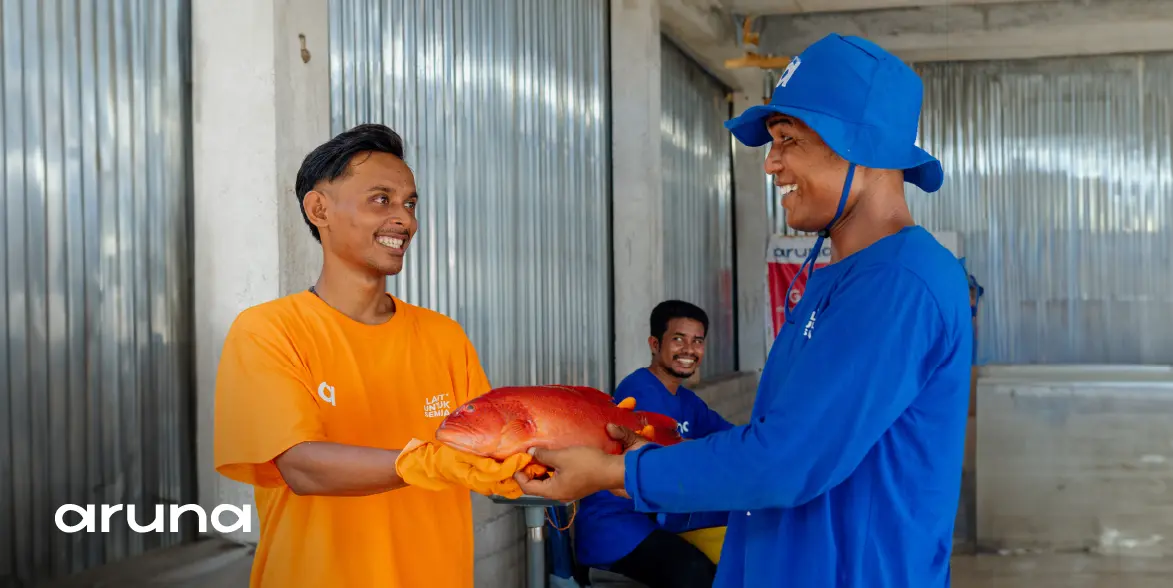
As a fisheries company committed to sustainability, Aruna utilizes product traceability standards to track all its products. Additionally, we implement environmentally friendly fishing practices and avoid overfishing, in line with regulations and principles of sustainable fisheries management.
Moreover, we believe that HR development is a crucial effort towards achieving fisheries sustainability. In this context, we ensure that all Aruna HR, including fishermen, coastal communities, and Local Heroes, understand the principles of sustainable fisheries and the importance of preserving the sea.
We invite the public and fisheries stakeholders to join efforts in supporting the PIT policy. All parties must actively contribute to preserving the sea and ensuring the sustainability of fisheries resources.
Through collaboration and shared commitment, we can achieve sustainable fisheries management and preserve marine ecosystems. The sea is a source of life for all living beings, and a sustainable sea will undoubtedly benefit society, the maritime sector, and fisheries in Indonesia.
Environmentally Friendly Fishing Tools for Marine Sustainability
The ocean provides various resources such as food, minerals, and oil. The sustainability of the marine ecosystem needs to be maintained to continue benefiting humanity. However, irresponsible human activities, such as destructive fishing, can threaten the sustainability of the ocean.
Destructive fishing involves capturing fish using tools that damage the marine ecosystem. This method can also lead to the death of unintended fish species. Examples of destructive fishing include the use of poisons, bombs, electric shock devices, trawl nets, or trawl lines. Data from the Ministry of Maritime Affairs and Fisheries (MMAF) shows that there were 653 cases of destructive fishing in Indonesia between 2013 and 2019. This evidence indicates that destructive fishing behavior has caused significant damage to the sea.
Environmentally Friendly Fishing Tools
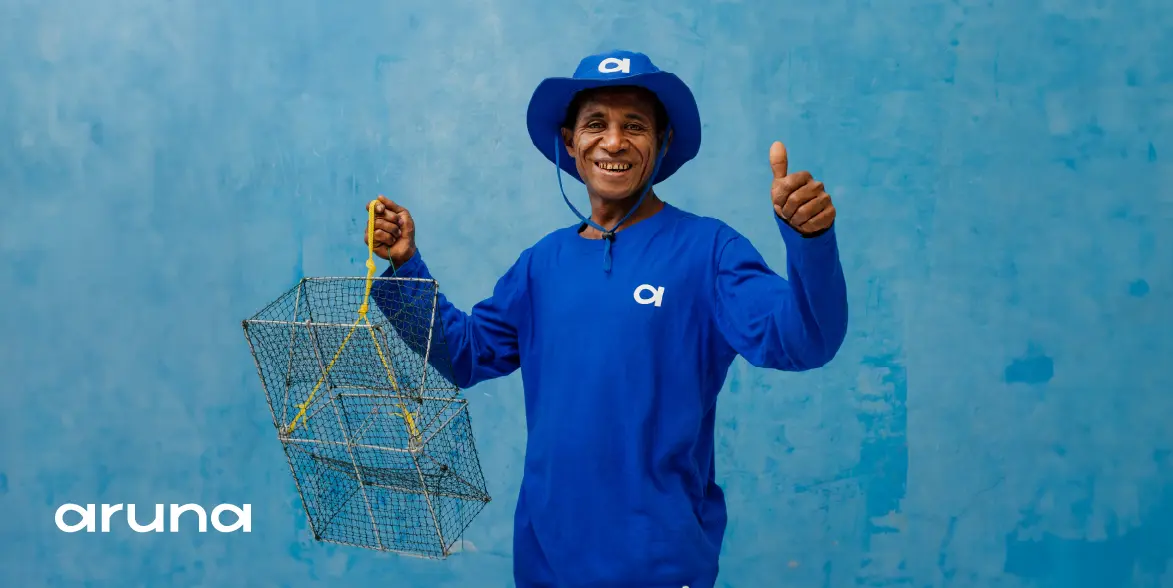
Environmentally friendly fishing tools are those that do not harm the marine ecosystem and fish. Here are three examples of environmentally friendly fishing tools used by fishermen:
a. Fish Traps (Bubu)
Bubu is a traditional fishing tool made from pieces of bamboo arranged and tied with plastic strings. Bubu comes in various shapes, such as square, cylindrical, or trapezoidal. It is placed in the path commonly taken by fish. The principle behind bubu is to trap fish by confusing their vision. Once the fish enters the Bubu, it becomes trapped and cannot escape. Bubu can also be used to catch blue crabs.
b. Gillnet
Gillnets are rectangular fishing nets with the same mesh size. They are designed to entangle fish, especially small to medium-sized ones. Using gillnets, fishermen can catch multiple fish at once.
c. Hook and Line
This fishing tool is used to attract the attention of the target fish, with or without bait. The target fish is caught on the hook attached to the line, and then it is pulled to the surface. Longlines and handlines fall under this category, with handlines typically used for catching large fish.
Impact of Using Environmentally Friendly Fishing Tools
The use of environmentally friendly fishing tools can provide various benefits, including preserving marine biodiversity, preventing damage to marine habitats, and improving the quality of fisheries products. Fishermen and vessels using environmentally friendly fishing tools contribute to the sustainability of the marine ecosystem. This aligns with the MMAF’s policies in implementing the Blue Economy.
Aruna’s Use of Environmentally Friendly Fishing Tools
Aruna is committed to using environmentally friendly fishing tools in its production process. We collaborate with fishermen to develop and use environmentally friendly fishing tools, such as Bubu. Bubu is employed to catch blue crabs, one of our flagship fisheries commodities.
The use of environmentally friendly fishing tools is an effort to protect the marine environment. To support marine ecosystem sustainability, you can choose fisheries products produced using environmentally friendly fishing tools. By choosing Aruna products, you can help maintain the sustainability of the sea. Together, we can contribute to preserving marine resources for future generations.
Maintaining the Quality of Fishery Products, Aruna Implements Hygiene and Sanitation in Production.
Fishery products are an important source of animal protein for the Indonesian population. However, the quality of fishery products can deteriorate if not properly maintained. To ensure that fishery products remain safe and healthy for consumption, one of the methods that can be implemented is to maintain good hygiene and sanitation during the production process.
We will discuss hygiene and sanitation in the fishery industry and the steps taken by Aruna, a fishery company that consistently provides safe and hygienic products.
Hygiene and Sanitation in the Fishery Industry
Hygiene and sanitation aim to maintain the cleanliness and safety of products by preventing contamination by microorganisms and harmful animals. Contamination can lead to various health problems, such as food poisoning and digestive infections. Therefore, fishery business operators must implement good hygiene and sanitation practices in the production process.
Hygiene and sanitation standards for processing fishery products are set by the government through the Minister of Marine and Fisheries Decree No. 52A/KEPMEN-KP/2013 concerning Quality Assurance and Safety Requirements for Fishery Product Production, Processing, and Distribution Processes. These standards require workers handling fishery products to implement good hygiene and sanitation in the workplace.
Benefits of Hygiene and Sanitation in the Fishery Industry
The implementation of good hygiene and sanitation can provide benefits to fishery products, including:
- Improving the quality, safety, and health of fishery products.
- Enhancing the competitiveness of fishery products.
- Building consumer trust.
Hygiene and sanitation also benefit workers and the environment. Good hygiene and sanitation practices can prevent the spread of diseases and environmental pollution. This makes the working environment comfortable, clean, and healthy.
Implementation of Hygiene and Sanitation by Aruna
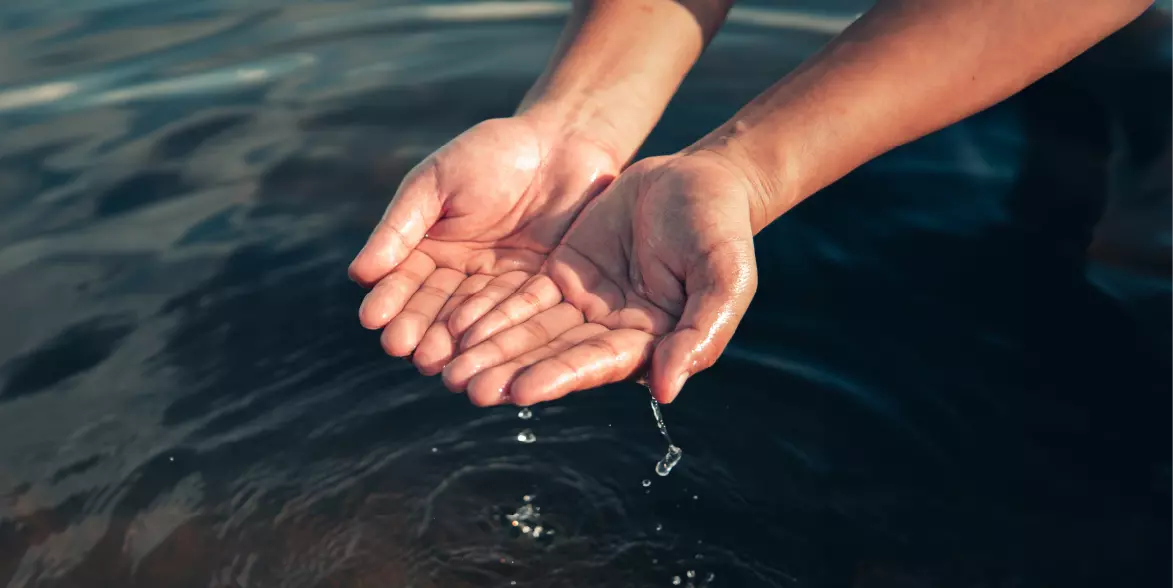
Aruna is committed to implementing good hygiene and sanitation in its production processes. To achieve this, Aruna provides hygiene and sanitation training to Aruna Pickers, who are members of the coastal community working to process fishery commodities. This training is provided by Aruna’s Quality Control (QC) team.
While working, Aruna Pickers are required to wear appropriate work attire following Standard Operating Procedures (SOP), including aprons, hairnets, masks, gloves, and waterproof shoes. The use of cosmetics and jewelry is not allowed. Additionally, Aruna Pickers receive education on how to maintain the cooling chain to minimize temperature fluctuations.
Diana Kartika Pramodhawardhani, a Young Expert in Capture Fisheries Production Management, hopes that coastal communities can continue to help maintain the quality of the fishermen’s catch. This is what allows Aruna to produce high-quality fishery products with quality assurance.
Hygiene and sanitation are crucial factors in maintaining the quality of fishery products. The good practices of hygiene and sanitation implemented by Aruna not only benefit fishery products but also the coastal community and the environment.
As consumers, we can also support the quality of fishery products, the welfare of coastal communities, and ocean sustainability by choosing products from companies that implement good hygiene and sanitation practices. With these small steps, we can create a better future for the Indonesian fishery industry.
Cocong, A Unique Local Dish from the Masalembu Islands
Cocong might sound unfamiliar to most people, but for the locals, it’s an essential part of Masalembu’s culture. The unique taste of cocong can be enjoyed when visiting Masalembu, and it can be an affordable and delicious food alternative.
Masalembu is part of Sumenep Regency, consisting of three main islands: Masalembu Island, Masakambing Island, and Karamian Island. To get there, it takes 7-18 hours by boat from Tanjung Perak Port or Kalianget Port in Surabaya. Let’s get to know cocong better and explore the maritime potential of the Masalembu Islands.
Getting to Know Cocong Cuisine
The main ingredient in cocong is rice. The rice is wrapped in leaves and steamed until it’s cooked. Cocong is similar to lontong, but it has a conical shape and a mild taste. Unlike lontong, which is typically a bit salty.
Usually, cocong is served with mackerel, grated coconut, sambal, and a broth made from fish stock, salt, and palm sugar, giving it a unique and delicious flavor. The combination of sweetness, saltiness, and richness makes cocong a special dish.
Because it’s not very large in portion, cocong is often sold in the afternoon. However, it can also be a lunch option. The very affordable price of cocong, which is only Rp 1,000 per serving, makes it a favorite food in Masalembu.
Maritime Potential of Masalembu
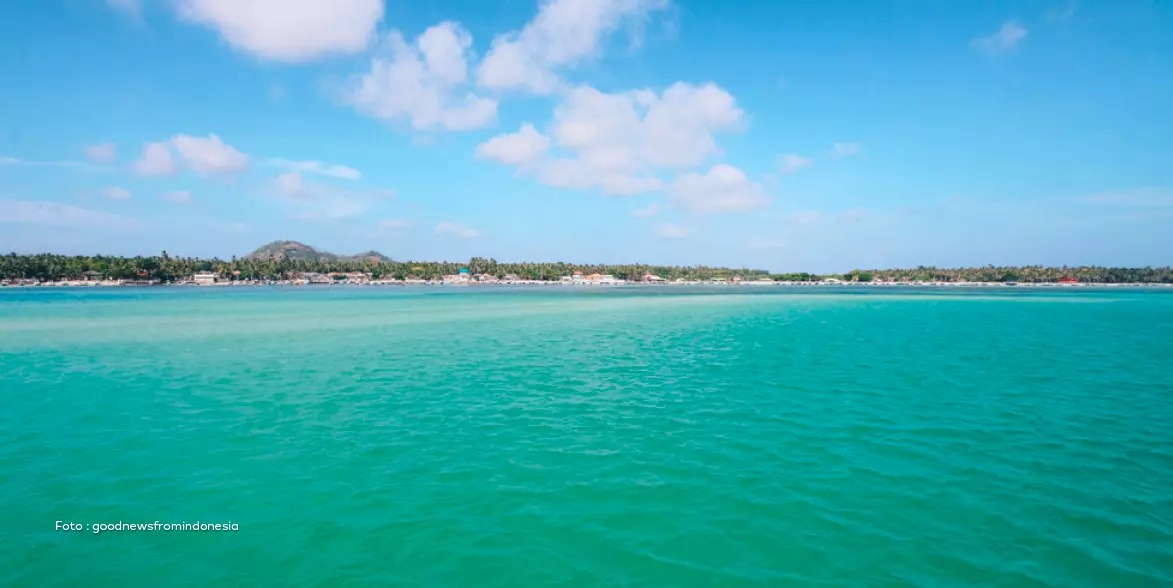
The deliciousness of cocong is closely tied to the abundant fisheries resources in the waters around Masalembu. Its strategic location provides a diverse range of marine resources. Some of the prominent fish species in these waters are tuna, mackerel, and flying fish.
Apart from traditional fishing, Masalembu also has the potential to develop aquaculture, including grouper and lobster farming. Seaweed and pearl farming also hold high economic value. On the other hand, the beauty of Masalembu’s waters attracts domestic and international tourists, especially for water sports like surfing and jetski.
The development of the marine sector brings significant benefits to the local population, such as increasing income, creating job opportunities, and improving food security.
Cocong: A Form of Fisheries Downstream Processing
Cocong is an example of downstream processing in Masalembu, where mackerel is turned into a ready-to-eat meal. This means that mackerel is not just sold as raw fish but can also have added value.
Additionally, Masalembu has the potential to develop seafood processing. Processed seafood products like dried fish, salted fish, and other seafood items have added value and can be sold in both local and international markets.
Downstream processing can be a way to enhance the welfare of local fishermen and the community. Collaboration with Aruna helps Masalembu’s fishermen sell their premium seafood products more efficiently and access a wider market.
For those who want to try cocong, you can visit Masalembu to savor this local delicacy at its place of origin. However, if you haven’t had the opportunity to visit the islands, you can make cocong at home using high-quality mackerel from Seafood by Aruna to create a delicious cocong dish.
Why Dolphins Don’t Drink Saltwater
Dolphins, like other mammals, breathe through their lungs. They need to surface regularly to breathe through blowholes located on the top of their heads. Despite spending most of their lives in the ocean, dolphins don’t drink seawater. So, how do they stay hydrated? Let’s delve into the facts!
Why Don’t Dolphins Drink Seawater?
The answer is simple: seawater contains extremely high salt levels. The high salt content in seawater can draw fluids out of a dolphin’s body, leading to dehydration and electrolyte imbalances.
Marine mammals, however, have adapted to the salty marine environment. They possess ‘super kidneys’ that can filter out excess salt from their bodies. Accumulated salt is excreted through special glands. This is why dolphins don’t need to worry about swallowing a small amount of seawater.
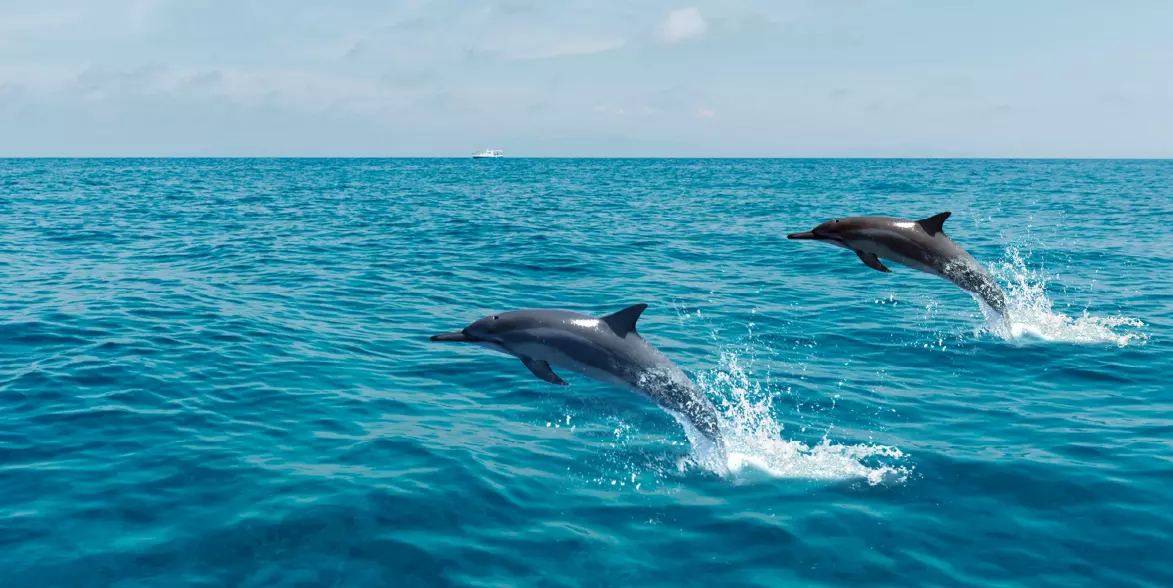
How Do Dolphins Get Fluids?
Dolphins obtain the necessary fluids from their diet, primarily fish. The body fluids of fish have lower salt levels compared to seawater. Therefore, dolphins don’t need to drink seawater to meet their hydration needs.
Each day, dolphins consume a significant amount of fish. An adult dolphin can eat up to 13 kg of fish per day. Additionally, they favor crustaceans and cephalopods as part of their diet.
Dolphins swallow their prey whole and, despite having teeth, they don’t chew their food. Their teeth are for capturing and holding prey to prevent it from escaping. While feeding, dolphins may inadvertently ingest seawater, but their excellent excretory system handles it efficiently.
What Happens If Dolphins Ingest Too Much Seawater?
Ingesting a significant amount of seawater can be highly detrimental to dolphins. The high salt content burdens their kidneys, which play a crucial role in eliminating metabolic waste from the body. This applies not only to dolphins but also to humans and other marine mammals.
In mild cases, dolphins ingesting excessive seawater may experience dehydration, weakness, and fatigue. In severe instances, they can suffer seizures, drown, or even die.
So, dolphins don’t drink seawater because of its high salt content. They acquire the fluids they need by consuming fish, and their excretory system helps remove excess salt, enabling them to thrive in the salty marine environment.
Understanding dolphin life helps us appreciate the importance of preserving the marine ecosystem they inhabit. Dolphins are integral to the ocean food chain and play a vital role in maintaining the balance of marine ecosystems.
Hence, it is essential to protect the cleanliness of the sea. Polluted waters pose a threat to dolphins and other marine creatures. Additionally, overfishing can lead to larger marine animals struggling to find sustenance, resulting in malnutrition, hunger, and even death. Overfishing can also disrupt marine ecosystem structures.
Let’s join hands with Aruna to safeguard the marine ecosystem, ensuring the well-being of fishermen and the availability of fish for future generations!
Embracing the Blue Economy: Indonesia’s Significant Reduction in Marine Plastic Waste
The United Nations has recognized Indonesia as the leading nation in land-based waste management to curb marine pollution. According to the National Coordination Team for Marine Plastic Waste Handling (TKN PSL), Indonesia has reduced plastic waste in its seas from 615,674 tons in 2018 to 398,000 tons in 2022. This achievement serves as a valuable lesson for island nations in the Archipelagic and Island States (AIS) community.
Over the past four years, Indonesia has successfully cut the inflow of plastic waste into its seas by approximately 39%. This demonstrates the government’s commitment to preserving marine ecosystems, as evidenced by Presidential Regulation (Perpres) No. 83 of 2018 on Marine Waste Management. The government has undertaken several initiatives, including:
Implementing an integrated approach to waste management from source to sea.
The primary source of plastic waste in the oceans is land-based. Consequently, Indonesia has not only concentrated on managing waste in coastal and marine areas but has also addressed the issue at its source. Measures include banning single-use plastics in industries, promoting waste separation between organic and non-organic materials, and encouraging the 3R principle: Reuse, Reduce, and Recycle. These efforts play a crucial role in preventing more plastic waste from reaching the seas.
Educating maritime industry stakeholders on marine waste management.
Apart from land-based sources, plastic waste also originates from ships, including cargo and passenger vessels. Raising awareness among maritime industry stakeholders can help reduce the volume of waste entering the oceans from ships. This education is essential to foster a sense of responsibility among industry stakeholders, ensuring their initiative to protect the marine environment.
Collaborating with neighboring countries to address plastic waste issues in Indonesian waters.
Admittedly, some of the plastic waste in Indonesian waters comes from other nations. Therefore, cooperation with relevant countries is necessary to tackle this issue. In mid-2023, Indonesia hosted the ASEAN-Indo-Pacific Workshop on Marine Plastic Debris. Together with ASEAN nations and Pacific Islands Forum (PIF) members, Indonesia discussed marine plastic waste management as a top priority.
The reduction in marine plastic waste is a result of collective efforts, including the ‘Month of Love for the Sea’ campaign initiated by the Ministry of Maritime Affairs and Fisheries (KKP). This campaign encourages citizens to clean up marine and coastal areas while raising awareness of the importance of preserving marine cleanliness.
Indonesia’s achievements in reducing marine plastic waste demonstrate its commitment to environmental preservation and climate change mitigation. Aruna supports marine conservation by providing education and assistance to fishermen, encouraging plastic waste reduction, waste sorting, reduced use of single-use plastics, and the use of eco-friendly products.
